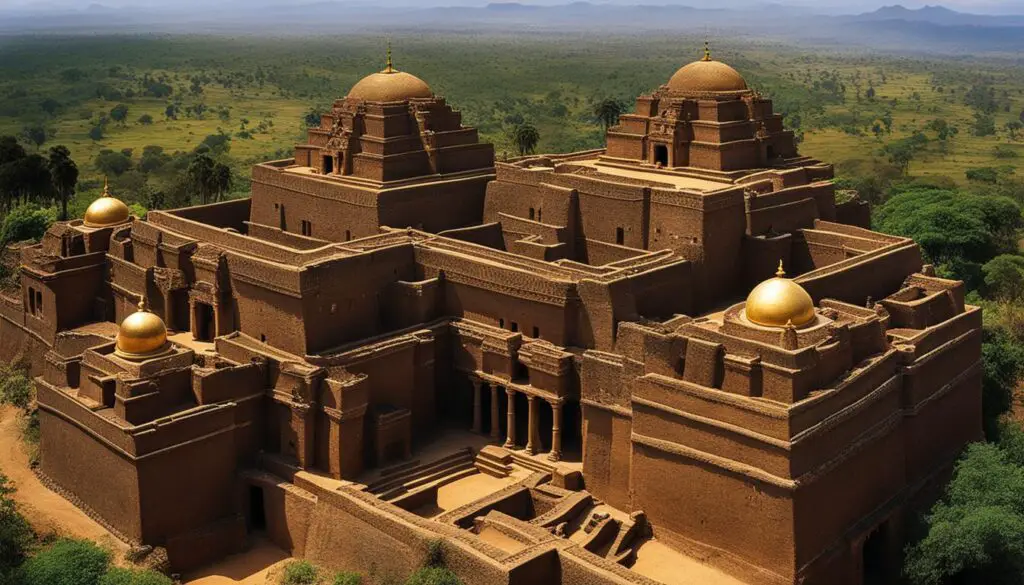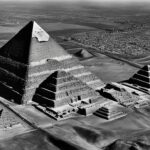Ethiopia, also known as Cush, has a fascinating history and a vibrant culture that spans centuries. This land holds significant biblical importance, with notable figures like Moses being connected to it. From its ancient traditions and remarkable heritage to its diverse culture, Ethiopia (Cush) offers a captivating journey through time and a deep exploration of its civilization.
Key Takeaways:
- Ethiopia (Cush) holds great biblical importance and is linked to notable figures like Moses.
- The land of Cush was a thriving civilization in biblical times, known for its advanced culture and trade connections.
- Major biblical events in Ethiopia (Cush) shaped its history and left a lasting impact on the region.
- Today, Ethiopia boasts a vibrant culture, diverse tribes, and numerous landmarks that showcase its rich heritage.
- Preserving Ethiopian heritage is crucial for maintaining its cultural identity and historical significance.
The Biblical Importance of Ethiopia (Cush)
Ethiopia, also known as Cush, holds great biblical importance. The land of Cush is mentioned multiple times in the Bible, showcasing its significance in biblical narratives. For instance, Moses, the revered biblical figure, married an Ethiopian woman, highlighting the connection between Ethiopia and prominent biblical figures.
Understanding the biblical importance of Ethiopia is crucial to unraveling its rich heritage. It allows us to explore the intersections between biblical events and the historical development of the region. Biblical figures linked to Ethiopia provide insights into the cultural and historical significance of the country, while major biblical events that took place in Ethiopia have had a lasting impact on its history.
Notable Biblical Figures Linked to Ethiopia (Cush)
| Biblical Figure | Relevance to Ethiopia |
|---|---|
| Moses | Married an Ethiopian woman |
| Queen of Sheba | Had a legendary encounter with King Solomon |
| Simon of Cyrene | Assisted Jesus in carrying the cross |
Exploring the lives of these biblical figures sheds light on the deep-rooted connections between Ethiopia and biblical narratives. It deepens our understanding of Ethiopian history and enhances our appreciation for the country’s cultural richness.
The Land of Cush in Biblical Times
In biblical times, the land of Cush, known today as Ethiopia, was a thriving civilization with a rich history and remarkable achievements. Situated in Northeast Africa, Cush was known for its advanced culture, architectural marvels, and extensive trade connections. The people of Cush were highly skilled in various fields, including agriculture, metallurgy, and architecture, which contributed to the region’s prosperity and cultural vibrancy.
One of the key aspects of Cush’s civilization was its strategic location, which made it an important center for trade between Africa, the Middle East, and the Mediterranean. Cush served as a hub for the exchange of goods, ideas, and cultural influences. This resulted in a diverse and cosmopolitan society, where different cultures and traditions merged to create a unique and dynamic environment.
Furthermore, Cush had a strong religious and mythological foundation, with its own pantheon of gods and goddesses. The people of Cush believed in the divine power of their rulers, known as the “Sacred Kings,” who were considered the intermediaries between the gods and the people. The sacred kings played a pivotal role in maintaining the spiritual and social order of Cush.

Table: Key Aspects of Cush’s Civilization
| Aspect | Description |
|---|---|
| Trade and Commerce | Cush served as a major trading hub, facilitating the exchange of goods between Africa, the Middle East, and the Mediterranean. |
| Architecture | Cush was renowned for its impressive architectural achievements, including monumental structures, palaces, and temples. |
| Cultural Exchange | Cush’s strategic location and diverse society allowed for the exchange of ideas, traditions, and cultural influences from different regions. |
| Religious Beliefs | The people of Cush had a rich religious and mythological tradition, with a pantheon of gods and goddesses, and revered sacred kings. |
| Technological Advancements | Cush pioneered advancements in agriculture, metallurgy, and other technological fields, contributing to its prosperity and cultural development. |
Exploring the land of Cush in biblical times provides valuable insights into the achievements, customs, and cultural richness of ancient Ethiopia. It allows us to appreciate the contributions of this thriving civilization and its lasting impact on the region and beyond.
Notable Biblical Figures Linked to Ethiopia (Cush)
Ethiopia (Cush) is closely intertwined with significant biblical figures, shedding light on the historical and cultural connections between the region and the biblical narrative. One notable biblical figure linked to Ethiopia is Moses, an influential leader of the Israelites. According to biblical accounts, Moses married an Ethiopian woman, which sparked curiosity and discussion.
This connection between Moses and Ethiopia highlights the cultural and historical significance of the region. It showcases the integration of Ethiopian heritage into the biblical narrative, emphasizing the intertwined nature of Ethiopia’s rich history with biblical events.
“And Miriam and Aaron spake against Moses because of the Ethiopian woman whom he had married: for he had married an Ethiopian woman.” – Numbers 12:1 (KJV)
Moses’ marriage to an Ethiopian woman not only reveals the cultural diversity of Ethiopia but also underscores the region’s place in biblical history. Exploring the lives of these biblical figures deepens our understanding of Ethiopia’s cultural and historical contributions.
Table: Notable Biblical Figures Linked to Ethiopia (Cush)
| Biblical Figure | Significance |
|---|---|
| Moses | Married an Ethiopian woman |
| Queen of Sheba | Visited King Solomon in Jerusalem |
| Ebed-Melech | Rescued and protected the prophet Jeremiah |
Exploring the lives and experiences of these biblical figures showcases the enduring connections between Ethiopia (Cush) and the biblical narrative. It illuminates the significant role Ethiopia played in shaping biblical events and emphasizes the rich cultural heritage that continues to thrive in the region.
Major Biblical Events in Ethiopia (Cush) and Their Impact
In the ancient land of Ethiopia (Cush), major biblical events unfolded, leaving a profound impact on its history and shaping its cultural narrative. These events, rooted in the biblical narrative, highlight the significance of Ethiopia as a backdrop for divine intervention and human triumph. Let us delve deeper into some of these noteworthy biblical occurrences and their lasting influence on the land.
Moses’ Military Conquests
One of the most significant biblical events in Ethiopia was Moses’ military conquests against the Ethiopians. According to historical accounts, Moses, the revered leader of the Israelites, led a successful campaign against the Cushite kingdom, solidifying his position as a central figure in Ethiopian history. This military conflict not only showcases the strategic importance of Ethiopia but also highlights the interconnectedness of biblical figures and the region’s historical narrative.
The Ethiopian Eunuch’s Conversion
Another major event in Ethiopian biblical history is the conversion of the Ethiopian eunuch. As documented in the New Testament, the Ethiopian eunuch, a high-ranking official in the Queen of Ethiopia’s court, encountered Philip the Evangelist. Through their interaction, the eunuch embraced the teachings of Christianity, marking a significant moment in the spread of the faith in Ethiopia. This conversion further solidified the country’s historical and religious connection with Christianity.
The Ark of the Covenant
One of the most intriguing biblical events associated with Ethiopia is the belief that the Ark of the Covenant, a sacred relic of immense religious significance, found its resting place in the northern part of the country. This belief is rooted in ancient traditions and legends, which have shaped Ethiopia’s cultural identity and drawn pilgrims and scholars from around the world to explore the mysteries surrounding the legendary ark.
These major biblical events in Ethiopia (Cush) hold tremendous historical impact and continue to shape the cultural and religious heritage of the land. Ethiopia’s rich biblical connections provide a unique lens through which to explore its captivating history and appreciate the profound influence of faith in the region.

| Biblical Event | Significance |
|---|---|
| Moses’ Military Conquests | Highlighted Ethiopia’s strategic importance and its interconnectedness with biblical figures. |
| The Ethiopian Eunuch’s Conversion | Marked a significant moment in the spread of Christianity in Ethiopia and solidified its religious connection. |
| The Ark of the Covenant | Shaped Ethiopia’s cultural identity and drew worldwide interest to the legendary ark’s rumored resting place. |
The Vibrant Culture of Ethiopia Today
Modern-day Ethiopia, also known as Cush, is a country that proudly embraces its rich cultural heritage. From traditional music and dance to ornate festivals and mouthwatering cuisine, Ethiopian culture is a vibrant tapestry that captivates both locals and visitors alike. The traditions and customs that have been passed down through generations reflect the deep-rooted history and resilience of the Ethiopian people.
The diversity of Ethiopian tribes adds to the cultural richness of the country. Each tribe has its distinct customs, language, and traditional attire. The Oromo, Amhara, Tigray, and many other tribes contribute to the multifaceted tapestry of Ethiopian culture, showcasing the country’s ethnic and linguistic diversity.
One of the most iconic aspects of Ethiopian culture is its traditional music and dance. The rhythmic beats, soul-stirring melodies, and energetic movements transport audiences to another world, steeped in history and emotion. The celebration of music and dance is deeply ingrained in Ethiopian culture, often serving as a way to express joy, commemorate significant events, or simply come together as a community.
Another remarkable facet of Ethiopian culture is its ancient traditions and rituals. From the elaborate Timkat festival, which celebrates the Ethiopian Orthodox Epiphany, to the mesmerizing coffee ceremonies that bring people together over a cup of freshly brewed coffee, these rituals reflect the deep cultural roots and hospitality of the Ethiopian people.

Traditional Ethiopian Music Instruments
| Instrument | Description |
|---|---|
| Kebero | A large hand drum played with sticks and used in religious and festive ceremonies. |
| Masinko | A single-stringed fiddle played with a bow, producing a distinct and haunting sound. |
| Krar | A lyre-like stringed instrument with five or six strings, commonly used in traditional Ethiopian music. |
| Washint | A traditional Ethiopian flute made from bamboo, producing a melodious and soulful tone. |
“Ethiopian culture is a testament to the country’s rich heritage, with its vibrant music, captivating dance, and ancient rituals. It is a tapestry that weaves together the past, present, and future of Ethiopia, inviting us to immerse ourselves in its colorful traditions and embrace its cultural diversity.”
Exploring the vibrant culture of modern-day Ethiopia is an immersive experience that reveals the depth of its traditions and the pride of its people. From the mesmerizing music and dance to the rich and diverse rituals, Ethiopia’s cultural heritage is a treasure that continues to thrive and evolve, showcasing the country’s unique identity to the world.
Exploring the Landmarks of Ethiopia
Ethiopia, also known as Cush, is a land steeped in history and cultural heritage. This remarkable country is home to a multitude of landmarks that offer insights into its rich past. From awe-inspiring ancient rock-hewn churches to breathtaking natural wonders, Ethiopia’s landmarks captivate visitors and reveal the depth of its historical and cultural significance.
One of the most notable landmarks in Ethiopia is the UNESCO World Heritage Site of Lalibela. This sacred complex is famous for its monolithic rock-cut churches, hewn out of solid volcanic rock in the 12th century. Visitors can explore these architectural marvels, experiencing the spiritual ambience and admiring the intricate carvings and frescoes that adorn the churches.
The Simien Mountains National Park is another must-visit landmark in Ethiopia. Known as the “Roof of Africa,” this breathtaking mountain range is home to diverse wildlife and stunning landscapes. Hiking through the park allows visitors to witness its dramatic cliffs, deep valleys, and endemic wildlife species, including the iconic Gelada baboons.
| Landmark | Description |
|---|---|
| Lalibela | A UNESCO World Heritage Site with monolithic rock-cut churches. |
| Simien Mountains National Park | A mountain range with dramatic cliffs and diverse wildlife. |
| Gondar | An ancient city known for its well-preserved castles and palaces. |
| Axum | An ancient city with historic obelisks and the Church of St. Mary of Zion. |
“Ethiopia’s landmarks are a testament to its rich cultural and historical heritage. These sites hold immense value not only for Ethiopians but also for the world. Exploring the landmarks of Ethiopia provides a unique opportunity to connect with the country’s past, marvel at its architectural wonders, and appreciate its natural beauty.”
Another significant landmark is the city of Gondar, known as the “Camelot of Africa.” Gondar was once the capital of Ethiopia and is renowned for its well-preserved castles and palaces. These magnificent structures showcase the architectural prowess of the Ethiopian people and provide a glimpse into the opulence of past emperors.
Axum, an ancient city in northern Ethiopia, is also a remarkable landmark. It is home to historic obelisks, including the towering Obelisk of Axum, and the Church of St. Mary of Zion, which is believed to house the Ark of the Covenant. Axum’s historical and religious significance makes it a must-visit destination for those interested in Ethiopian history and culture.
Exploring these landmarks allows visitors to immerse themselves in Ethiopia’s rich tapestry of history and culture. Each site holds a unique story and offers a glimpse into the country’s vibrant heritage. Whether you’re captivated by the rock-hewn churches of Lalibela, the majestic landscapes of the Simien Mountains, or the architectural wonders of Gondar and Axum, Ethiopia’s landmarks are sure to leave a lasting impression.
The Diversity of Ethiopian Tribes
Ethiopia, also known as Cush, is a country rich in cultural diversity and ethnic groups. The land is home to numerous tribes, each with its unique customs, languages, and traditions. The Oromo, Amhara, Tigray, and many other tribes have played a significant role in shaping the history and cultural landscape of Ethiopia. The diversity of Ethiopian tribes is a testament to the country’s vibrant tapestry of traditions and heritage.
The ethnic groups of Ethiopia offer a glimpse into the country’s fascinating history and the interconnectedness of its people. Each tribe has its distinct identity, adding to the colorful mosaic of Ethiopian culture. From the pastoralist tribes of the Omo Valley to the highland communities of the Amhara and Tigray, the different tribes contribute to the country’s rich cultural fabric.
Exploring the diversity of Ethiopian tribes allows us to appreciate the various languages, traditional crafts, music, and dance forms that thrive within the country. It showcases the resilience and unity of the Ethiopian people, who have preserved their unique cultural identities throughout history. The diversity of tribes in Ethiopia is a source of pride and an integral part of the nation’s cultural heritage.
Traditional Clothing and Adornments of Ethiopian Tribes
The tribes of Ethiopia are known for their distinctive traditional clothing and adornments. Each tribe has its distinct style, reflecting their cultural heritage and social identity. For example, the Oromo people are often recognized for their colorful handwoven textiles, while the Afar tribe is known for its unique jewelry made from silver and other metals.
Traditional clothing and adornments hold significant cultural and symbolic value for Ethiopian tribes. They not only serve as expressions of identity but also as a means of preserving ancestral customs and traditions. The intricate patterns, vibrant colors, and intricate details of the garments and accessories reflect the rich cultural diversity of Ethiopia’s tribes.
Preserving Cultural Diversity in Ethiopia
Preserving the cultural diversity of Ethiopian tribes is crucial for maintaining the country’s unique heritage. Efforts are being made to protect and promote the traditional knowledge, practices, and customs of these tribes. Local communities, cultural organizations, and the government are working together to document and safeguard their intangible cultural heritage.
By preserving the diverse cultural expressions of Ethiopian tribes, the country can celebrate its multicultural identity and promote intercultural understanding. It also helps to foster sustainable tourism that respects and supports local communities. The preservation of cultural diversity in Ethiopia is an ongoing journey that seeks to ensure the vibrancy and continuity of the country’s rich tapestry of traditions.
| Tribes | Region | Main Language |
|---|---|---|
| Oromo | Oromia | Afaan Oromoo |
| Amhara | Amhara | Amharic |
| Tigray | Tigray | Tigrinya |
| Afar | Afar | Afar |
| Sidama | Southern Nations, Nationalities, and People’s Region | Sidamic |
Preserving Ethiopian Heritage
Ethiopia’s rich heritage is a treasure trove of cultural and historical significance. To ensure the preservation of this invaluable legacy, concerted efforts are being made to safeguard Ethiopia’s heritage sites, artifacts, and traditions. By protecting and conserving these assets, we can secure a vibrant future for Ethiopian culture.
One of the key initiatives in cultural preservation is the establishment of heritage sites. These sites, such as the iconic rock-hewn churches of Lalibela, showcase the architectural marvels of ancient Ethiopia. They serve as living testaments to the skill and creativity of our ancestors. Preserving these sites not only allows future generations to marvel at their beauty, but also fosters a sense of pride and connection to our shared history.
Historical conservation is another essential aspect of preserving Ethiopian heritage. The conservation of historical artifacts, manuscripts, and artworks ensures that they continue to be accessible for research, education, and appreciation. Specialized conservation efforts, including proper storage, restoration, and documentation, are vital to maintain the integrity and longevity of these precious objects.
| Heritage Sites | Historical Conservation |
|---|---|
| The rock-hewn churches of Lalibela | Conservation of ancient manuscripts |
| The ancient city of Aksum | Restoration of historical artifacts |
| The Fasil Ghebbi in Gondar | Proper storage of cultural relics |
Furthermore, educational programs and community engagement play a crucial role in cultural preservation. By raising awareness about Ethiopian heritage and instilling a sense of responsibility among the local communities, we can ensure their active participation in safeguarding our cultural treasures. Collaborative efforts between government institutions, non-profit organizations, and local communities are essential for long-term success in preserving Ethiopian heritage.
In conclusion, the preservation of Ethiopian heritage is an ongoing endeavor that requires collective dedication and commitment. Through the establishment of heritage sites, historical conservation, and community engagement, we can secure the rich cultural legacy of Ethiopia for generations to come. By valuing and protecting our heritage, we celebrate our identity and contribute to the broader tapestry of human civilization.
The Influence of Ethiopia’s Cush Empire
Ethiopia’s rich history and cultural legacy are intricately tied to the influence of the Cush Empire. This powerful kingdom, also known as the Kingdom of Kush, played a significant role in shaping ancient African civilizations. From its remarkable achievements to its cultural exchange and architectural wonders, the impact of the Cush Empire can still be felt today.
The Cush Empire thrived for centuries, leaving behind a formidable legacy. One of its notable contributions was the establishment of trade routes that connected different regions of Africa. These routes facilitated the exchange of goods, knowledge, and ideas, contributing to the growth and development of various African civilizations.
Moreover, the Cush Empire’s architectural marvels stand as a testament to its advanced civilization. The Nubian pyramids, similar to those found in Egypt, bear witness to the empire’s wealth and power. These structures, along with other monumental buildings and temples, highlight the empire’s skilled craftsmanship and artistic expression.

The influence of the Cush Empire extends beyond its borders. It fostered cultural exchange and interaction among different African societies, contributing to the development of shared traditions and beliefs. The empire’s rich cultural heritage continues to inspire and shape modern-day Ethiopia, as well as other African nations, emphasizing the enduring influence of this ancient civilization.
Ethiopia (Cush) and its Role in African History
Ethiopia, also known as Cush, has played a vital role in African history. Situated in the northeastern part of Africa, this land has been a center of civilization and a hub for trade and cultural exchange for centuries. Its strategic location along ancient trade routes contributed to its historical significance and influence.
In biblical times, Ethiopia held great importance and was mentioned multiple times in the Bible. Notable biblical figures like Moses and his Ethiopian wife were linked to Ethiopia, highlighting its connections to the biblical narrative. Major events, such as Moses’ military conquests against the Ethiopians, impacted the region and shaped its history.
Today, Ethiopia’s impact can still be felt. The country boasts a vibrant culture that showcases its diverse traditions and customs. The rich tapestry of Ethiopian tribes and ethnic groups contributes to the country’s cultural diversity and heritage. Additionally, Ethiopia is home to numerous landmarks and historical sites that reflect its rich history, such as the ancient rock-hewn churches of Lalibela.
| Key Points | Details |
|---|---|
| Biblical Importance | Ethiopia (Cush) holds biblical significance, with notable figures like Moses linked to the land. |
| Notable Biblical Figures | Moses and his Ethiopian wife are among the prominent biblical figures associated with Ethiopia. |
| Biblical Events and Impact | Major biblical events in Ethiopia, such as Moses’ military conquests, shaped the region’s history. |
| Vibrant Culture | Modern-day Ethiopia boasts a vibrant culture that celebrates its traditions and heritage. |
| Landmarks and Sites | Ethiopia is home to numerous landmarks and historical sites, providing insights into its rich history. |
Exploring Ethiopia’s historical significance and cultural impact is essential to understanding the depth of African history. The country’s enduring traditions and contributions to civilization make it a cornerstone of African heritage. Ethiopia’s role in African history invites visitors to delve into its fascinating past and appreciate the interconnectedness of nations within the continent.

References:
- “Ethiopia (Cush)”, Encyclopædia Britannica
- “The Historical Significance of Ethiopia in the Bible”, University of Pennsylvania Museum of Archaeology and Anthropology
- “Ethiopia’s Cultural Heritage”, UNESCO
Conclusion
Ethiopia (Cush) stands as a testament to the rich history and captivating culture of this remarkable land. With its biblical importance deeply rooted in ancient times, Ethiopia has been connected to notable biblical figures such as Moses and his Ethiopian wife. In biblical times, Ethiopia flourished as a prosperous civilization, known for its advanced culture and impressive architectural marvels.
Major biblical events that unfolded in Ethiopia have left a lasting impact on its history, shaping political, cultural, and religious aspects of the region. These events, including Moses’ military conquests, have played a pivotal role in the narrative of Ethiopia’s heritage.
Today, Ethiopia continues to exude its vibrant culture, showcasing a tapestry of diverse traditions and customs. The country’s landmarks, such as the rock-hewn churches of Lalibela and the breathtaking Simien Mountains, provide a glimpse into its rich historical and cultural heritage.
Preserving Ethiopian heritage is crucial to maintaining its cultural identity and historical significance. Efforts are underway to protect and conserve ancient sites, artifacts, and traditions, ensuring that Ethiopia’s unique cultural legacy can be cherished by future generations. Ethiopia’s impact on African history and its enduring civilization make it a captivating destination for those seeking to immerse themselves in a land rich with traditions, diversity, and heritage.
FAQ
What is the biblical importance of Ethiopia (Cush)?
Ethiopia (Cush) is mentioned multiple times in the Bible, and notable biblical figures like Moses and his Ethiopian wife are connected to it. Understanding the biblical importance of Ethiopia is crucial to unraveling its rich heritage.
What was the significance of the land of Cush in biblical times?
In biblical times, the land of Cush (Ethiopia) was a thriving civilization known for its advanced culture, architectural marvels, and trade connections. Exploring the land of Cush in biblical times provides valuable insights into the culture and achievements of the ancient Ethiopians.
Which biblical figures are linked to Ethiopia (Cush)?
Moses, the leader of Israel, married an Ethiopian woman, highlighting the connection between Moses and Ethiopia. Exploring the lives of these biblical figures sheds light on the cultural and historical significance of Ethiopia.
What major biblical events took place in Ethiopia (Cush) and how did they impact the region?
Ethiopia (Cush) was the backdrop for major biblical events, such as Moses’ military conquests against the Ethiopians. These events influenced political, cultural, and religious aspects and left a lasting imprint on the land.
What is the vibrant culture of Ethiopia today?
Ethiopia is known for its diverse tribes and ethnic groups, each with its distinct customs, language, and traditions. Exploring the vibrant culture of modern-day Ethiopia is an immersive experience that reveals the depth of its traditions.
What landmarks in Ethiopia showcase its historical and cultural heritage?
Ethiopia is home to numerous landmarks, such as the ancient rock-hewn churches of Lalibela and the stunning landscapes of the Simien Mountains. These sites offer a glimpse into the rich tapestry of Ethiopian history.
What is the diversity of Ethiopian tribes?
Ethiopia is home to diverse tribes like the Oromo, Amhara, Tigray, and many others, each with its own customs and traditions. Understanding the diversity of Ethiopian tribes is key to appreciating the country’s cultural richness.
How is Ethiopian heritage being preserved?
Efforts are being made to protect and conserve ancient sites, artifacts, and traditions in Ethiopia. Organizations and institutions are working towards safeguarding Ethiopia’s heritage for future generations.
What influence did Ethiopia’s Cush Empire have on ancient African civilizations?
The Cush Empire, also known as the Kingdom of Kush, exerted a significant influence on ancient African civilizations through its architectural wonders, trade routes, and cultural exchange.
What role did Ethiopia (Cush) play in African history?
Ethiopia (Cush) served as a center of civilization, trade, and cultural exchange in African history. Understanding Ethiopia’s role is essential to grasping the continent’s diverse past and the interconnectedness of its nations.
What is the conclusion regarding the rich history and culture of Ethiopia?
Ethiopia’s rich history, biblical importance, vibrant culture, and impressive heritage make it a fascinating destination. Exploring its landmarks, preserving its heritage, and understanding its historical significance are critical to appreciating the depth of Ethiopian culture.







